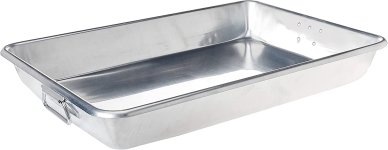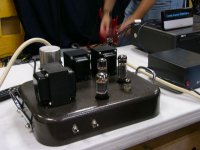Am about to begin building a long-time-planned amp for Bass, and pedal steel. A circuit using 8 1625 finals ( 12V 807s) driven by 12SN7s (12V versions of the 6SN7) into AB2 operation. Not a problem for me to do the circuit-fiddling at all ( so long as I stay out of joining the 650V circuit - and becoming a part of it) The sheet metal stuff has me stymied though. Need to build a decent solid chassis to house 8 807 tubes, a pair of XSN7 drivers, and a XSN7 PI...... with a ******* hand drill, tin snips and Dremel......
There must be an easier way........
There must be an easier way........
Kinda sounds like you could go with the "frying pan" route for a robust type chassis...
BTW, this thing is huge, twenty six inches long...
---------------------------------------------------------------------------------------------------------------------Rick...
BTW, this thing is huge, twenty six inches long...
---------------------------------------------------------------------------------------------------------------------Rick...
Attachments
I'm guessing it's just a box with some holes you're looking to build, right? If you want it to look nice then you can build it out of a single piece of metal but you'll need a press brake to do so. You could also weld/braze a bunch of pre-cut pieces as well but I don't know if you have access to those tools either.Need to build a decent solid chassis to house 8 807 tubes, a pair of XSN7 drivers, and a XSN7 PI...... with a ******* hand drill, tin snips and Dremel......
There must be an easier way........
This is an example of a "small" amp built on such a chassis. Peruse a large well stocked "kitchen supply" outlet...
-------------------------------------------------------------------------------------------------------------------------------------Rick...
-------------------------------------------------------------------------------------------------------------------------------------Rick...
Attachments
https://www.landfallsystems.com/
https://www.protocase.com/
https://www.frontpanelexpress.com/
Just to name a few.
Tom
https://www.protocase.com/
https://www.frontpanelexpress.com/
Just to name a few.
Tom
Landfall Chassis' website is still down. I talked to the guy I deal with there and he was frustrated. Had me contact the webmaster a few weeks ago but no progress. He did say they were still building chassis. Love their stuff!
http://www.par-metal.com/product.php Did a custom size of their series 20 case in just a few days.
http://www.par-metal.com/product.php Did a custom size of their series 20 case in just a few days.
I'd suggest aluminium for the chassis: easy to cut on a table saw (given you have access to one) with a good non-ferous metal cutting blade. You can also score the aluminium where you want it bent and it'll bend nicely. Also non-magnetic so eliminates all the strange things transformers induce in steel.
I’ve been having good luck with 1”x2” aluminum u-channel and 12x12 pieces for the top and bottom.
I’ve got a miter saw that I’ve purchased and installed the proper metal cutting blade for, a good set of clamps and some lubricant, and I’m getting ready to cut 0.125” aluminum U-channel. I’ve put a block of wood on either side to keep it from being misshapen. But I’m a bit sketched out by the thought of the blade getting caught and flinging a chunk of jagged metal at me at Mach 3.I'd suggest aluminium for the chassis: easy to cut on a table saw (given you have access to one) with a good non-ferous metal cutting blade. You can also score the aluminium where you want it bent and it'll bend nicely. Also non-magnetic so eliminates all the strange things transformers induce in steel.
What’s the proper motion for the blade? Slow and deliberate? Something else? Thanks.
If you use "pure" aluminium (1xxx series) rather than aluminium alloys (2xxx, 3xxx, etc), you'll find its awful to cut and machine, really soft and claggy - and possibly dangerous to use a power saw on. Alloys are much better, most are hard enough to be free-cutting, especially with a little light oil or cutting lubricant.
Fortunately most extruded section is alloy. To figure out if some aluminium is pure or alloy just drill a hole with medium sized drill bit - if the exit burr is massive, its likely the pure metal in annealed state.
"Feeds and speeds" for metal cutting are available from many sources, but you should always start slower than the tables say to get a feel for it, especially if your tools are not brand new sharp and precision made. PPE always - but for machine tools don't wear gloves - they can snag and pull your hand into the path of the cutter.
Fortunately most extruded section is alloy. To figure out if some aluminium is pure or alloy just drill a hole with medium sized drill bit - if the exit burr is massive, its likely the pure metal in annealed state.
"Feeds and speeds" for metal cutting are available from many sources, but you should always start slower than the tables say to get a feel for it, especially if your tools are not brand new sharp and precision made. PPE always - but for machine tools don't wear gloves - they can snag and pull your hand into the path of the cutter.
Thank you, that is very helpful. I’ll verify the type, but it seems likely it is alloy because I’ve used both regular and Forstner bits on a drill press to cut nice holes without too much burr, and it seems fairly light, the stuff that is generated.
The tools I do have are mostly Bosch and I keep them in good condition. I only buy stuff one at a time as I can afford them, but quality over quantity. Especially since I’m a computer nerd who really wants to work with my hands other than a keyboard for a change.
It’s slow going because I try to be safe. I did make a crossover with the same type of top that Mr. TubeLab did. It looks tough. 😁
Thanks again.
The tools I do have are mostly Bosch and I keep them in good condition. I only buy stuff one at a time as I can afford them, but quality over quantity. Especially since I’m a computer nerd who really wants to work with my hands other than a keyboard for a change.
It’s slow going because I try to be safe. I did make a crossover with the same type of top that Mr. TubeLab did. It looks tough. 😁
Thanks again.
I stick to 6061 aluminum that is 3 to 4mm thick. I get cut off remnants for cheap at the huge metal supply place. It cut and drills easily and cleanly. I use a wooden frame routed out to fit the thickness of the aluminum. This is for my tube amps. For SS amps I use the same aluminum with L brackets to connect the sides to the top and bottom. I drill and tap into the sheet for screws to hold it together. It’s a lot of work but it comes out well.
Thanks! It is a lot of work to do the tapping. I found that out the hard way, but it really is worth it. It took a lot of practice to get good at that.
Also, do you use the wooden frame for tube amps for electrical safety reasons. I have made sure that each piece has a solid connection to safety ground. And with really careful planning of where ground connections are and avoiding loops with audio ground the hum is inaudible to me, at least.
Also, do you use the wooden frame for tube amps for electrical safety reasons. I have made sure that each piece has a solid connection to safety ground. And with really careful planning of where ground connections are and avoiding loops with audio ground the hum is inaudible to me, at least.
Last edited:
Some great links/companies in this thread - do anyone know of EU or UK based companies that similar services?
^Hi, in EU:
https://www.schaeffer-ag.de/en/front-panel-designer/?lang=en
Great service and products. Not cheap, but if you want pro outcome it'll be.
https://www.schaeffer-ag.de/en/front-panel-designer/?lang=en
Great service and products. Not cheap, but if you want pro outcome it'll be.
- Home
- Design & Build
- Construction Tips
- Need help with sheet metal work...

